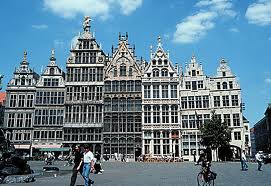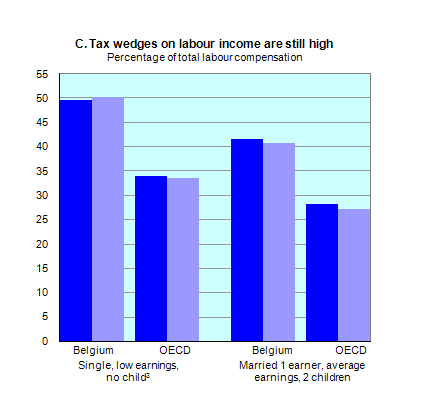Belgium: Belgium Finance Profile 2011
2012/02/22
Belgium Finance Profile 2012
The banking sector has stabilized after massive public intervention, but its financial situation remains fragile and vulnerable to potential spillovers from mature markets and emerging Europe. The uncertain profitability outlook constrains the banks’ capacity to rebuild a high-quality capital base through internal capital generation. The withdrawal from the emergency support to the financial sector will be done gradually to avoid market disruptions and a credit squeeze. The authorities have initiated the creation by early 2011 of a unified structure to supervise financial institutions at the National Bank of Belgium, in order to more effectively combine the supervision of individual institutions and of the system as a whole. A draft crisis law that would establish a rule-based resolution framework for failed financial institutions has also been prepared.
Foreign Investment
 Foreign investment contributed significantly to Belgian economic growth in the 1960s. In particular, U.S. firms played a leading role in the expansion of light industrial and petrochemical industries in the 1960s and 1970s. The Belgian Government encourages new foreign investment as a means to promote employment. With regional devolution, Flanders, Brussels, and Wallonia now have substantial autonomy in courting potential foreign investors, as each deems appropriate.
Foreign investment contributed significantly to Belgian economic growth in the 1960s. In particular, U.S. firms played a leading role in the expansion of light industrial and petrochemical industries in the 1960s and 1970s. The Belgian Government encourages new foreign investment as a means to promote employment. With regional devolution, Flanders, Brussels, and Wallonia now have substantial autonomy in courting potential foreign investors, as each deems appropriate.
Foreign direct investment (stock) totaled more than $705 billion (cumulative) in 2009. U.S. and other foreign companies in Belgium account for approximately 11% of the total work force, with the U.S. share at about 6%. U.S. companies are heavily represented in the chemical sector, automotive assembly, petroleum refining, and pharmaceutical sectors. A number of U.S. service industries followed in the wake of these investments--banks, law firms, public relations, accounting, and executive search firms. The resident American community in Belgium now exceeds 20,000. Attracted by the EU 1992 single-market program, many U.S. law firms and lawyers have settled in Brussels since 1989.
Monetary
On May 1, 1998, Belgium became a first-tier member of the European Monetary Union. Belgium switched from the Belgian franc (BF) to the Euro as its currency after January 1, 2002.
Trade
Most of Belgium's trade is with fellow EU member states. As a result, Belgium seeks to diversify and expand trade opportunities with non-EC countries. Through November 2010, Belgium ranked as the 14th-largest market for the export of U.S. goods.
Bilaterally, there are few points of friction with the U.S. in the trade and economic area. The Belgian authorities are, as a rule, anti-protectionist and try to maintain a hospitable and open trade and investment climate. As a result, the U.S. Government focuses its market-opening efforts on the EU Commission and larger member states. Moreover, the Commission negotiates on trade issues for all member states, which in turn lessens bilateral trade disputes with Belgium.
Employment
The social security system, which expanded rapidly during the prosperous 1950s and 1960s, includes a medical system, unemployment insurance coverage, child allowances, invalid benefits, and other benefits and pensions. With the onset of a recession in the 1970s, this system became an increasing burden on the economy and accounted for much of the government budget deficits. The national unemployment figures mask considerable differences between Flanders and Wallonia. Unemployment in Wallonia is mainly structural, while in Flanders it is cyclical. Flanders' unemployment level equals only half that of Wallonia. The southern region continues a difficult transition out of sunset industries (mainly coal and steel), while sunrise industries (chemicals, high-tech, and services) dominate in Flanders.
Belgium's unemployment rate was 8.3% in November 2010. A total of 4.47 million people make up Belgium's labor force. The majority of these people (73%) work in the service sector. Belgian industry claims 25% of the labor force and agriculture only 2%. As in other industrialized nations, pension and other social entitlement programs have become a major concern as the "baby boom" generation approaches retirement.
Budget
Although Belgium is a wealthy country, public expenditures far exceeded income for many years, and taxes were not diligently pursued. The Belgian Government reacted with poor macroeconomic policies to the 1973 and 1979 oil price hikes by hiring the redundant work force into the public sector and subsidizing industries like coal, steel, textiles, glass, and shipbuilding, which had lost their international competitive edge. As a result, cumulative government debt reached 121% of GDP by the end of the 1980s. However, thanks to Belgium's high personal savings rate, the Belgian Government financed the deficit from mainly domestic savings, minimizing the deleterious effects on the overall economy.
The federal government ran a 7.1% budget deficit in 1992 at the time of the EU's Treaty of Maastricht, which established conditions for Economic and Monetary Union (EMU) that led to adoption of the common Euro currency on January 1, 2002. Among other criteria spelled out under the Maastricht treaty, the Belgian Government had to attain a budget deficit of no greater than 3% of GDP by the end of 1997; Belgium achieved this, with a total budget deficit in 2001 (just prior to implementation of the Euro currency) that amounted to 0.2% of GDP.
The government had a positive primary balance between 1993 and 2007, during which time Belgium’s debt to GDP level fell from 133% to just over 84%. In 2009, due to the financial and economic crisis, Belgium’s deficit and debt levels increased to 6% and 96.2% of GDP respectively, with debt rising to close to 97% of GDP in 2010. Thanks to improving economic growth, Belgium’s budget deficit was 4.6% in 2010. According to the country’s Stability Program, the deficit is planned to be 4.1% in 2011 and 3.0% in 2012, although the government signaled in early 2011 that it wants to bring the 2011 deficit to below 4.0%.
- Belgium News
-
- AFGHANISTAN: UNWTO: International tourism – strongest half-year results since 2010
- ALBANIA: US LNG exports make European market more competitive
- BELGIUM: Belgium Consumer Confidence Unchanged In August
- BELGIUM: Brussels Tourism launches its first Urban Culture Guide
- AFGHANISTAN: Higher earning Why a university degree is worth more in some countries than others
- BELGIUM: Belgium green lights unchanged Ceta
- Trending Articles
-
- CHINA: China welcomes Guinea to take part in Belt and Road Initiative
- CAMEROON: Poor End of Year Results for Cameroon Students
- AUSTRALIA: Queensland Bauxite Gains State Approval of Mineral Development Work Program
- CHINA: Chinese-supported infrastructure projects change Zambia's landscape
- UNITED STATES: Spotify, Hulu target students with discounted bundle
- UGANDA: Ugandan Govt Starts Verifying International Academy Teachers














